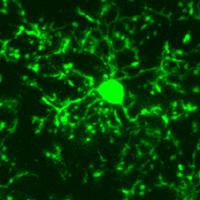
Microglial cell in the brain of transgenic mouse. The extensions of the microglial cells are not static, they change constantly. Image: MPI for Medical ResearchResearchers from the Max Planck Institute for Medical Research in Heidelberg and the Max Planck Institute of Experimental Medicine in Goettingen (Germany) have uncovered the behaviour of microglial cells in the brain. In the current online edition of Science (Science, Epub ahead of print, 14. April 2005) they report on the busy action of these immune defense cells in the normal brain and their rapid response to cerebral hemorrhage in the first few hours following injury. Their imaging approach is transferable to other models of disease, and monitoring microglia behaviour under such circumstances promises to substantially enhance our knowledge about brain pathologies.
Microglial cells are the primary immunocompetent cells in the brain. They are the first responsive element to any kind of brain damage or injury. Microglia are critically involved, for example, in neurodegenerative diseases and stroke. So far, microglial cells have been studied in vitro, i.e. outside the living organism. As a result, key aspects of microglia function have remained elusive such as their behavior in the intact brain or their immediate response to brain injury.
Now a German team of researchers from two Max Planck Institutes in Heidelberg and Goettingen (Germany) report a breakthrough in the study of microglial cells in vivo. They uncovered the behaviour of microglial cells in the intact brain by making use of two key technologies: two-photon microscopy and a transgenic mouse model. While mice employed in their experiments were genetically modified to produce a green fluorescent protein (GFP), infrared laser light was used to excite GFPs and thus to visualize stained cells in the micoscope via detection of emitted fluorescent light - even through the intact mouse skullcap. Their findings appear in this weeks online edition of Science (Epub ahead of print).
In their paper, Axel Nimmerjahn and fellow authors Frank Kirchhoff and Fritjof Helmchen provide a detailed description of microglia behavior in the normal brain and in response to cerebral hemorrhage. In the normal brain, the researchers found that fine processes of so called "resting" microglial cells are not at rest at all. Rather, they constantly sampled their microenvironment with highly motile processes and protrusions. In doing so, they continually interacted with neurons and other cells in the brain. "This persistent interaction seems to be particularly important in maintaining regular brain function" says Frank Kirchhoff.
The team, led by Fritjof Helmchen at the Max Planck Institute in Heidelberg, induced cerebral hemorrhage by causing targeted disruptions of the blood-brain barrier through brief, intense and highly localized laser illumination. "Such injuries may serve as a model for hypertension-induced stroke, that is manifested by bursting of a - in general larger - blood vessel leading to damage of surrounding areas" says Axel Nimmerjahn. The researches found that within a few minutes processes of microglial cells rushed through the gaps of surrounding tissue towards the injured blood vessel segment, apparently shielding the injured site, followed by decomposition of damaged or marred tissue. Notably, the larger the affected area the more microglial cells participated in the immune response.
"We take it that our approach to monitor microglia in vivo can be transferred to other models of disease, for example, existing animal models of Alzheimers disease and thus to contribute to a better understanding of these busy housekeepers in the brain" says Fritjof Helmchen. Deciphering the complex actions and cellular mechanisms underlying microglia function in health and disease may be critical to the development of new therapeutic approaches for both treatment and prevention of brain pathology.
Reference:
Nimmerjahn, A., Kirchhoff, F., Helmchen, F.
Resting Microglial Cells are Highly Dynamic Surveillants of Brain Parenchyma in vivo
Science, Epub ahead of print, 14 April 2005
Source : Max-Planck-Gesellschaft
 Print Article
Print Article Mail to a Friend
Mail to a Friend
